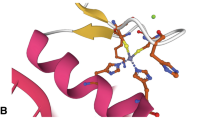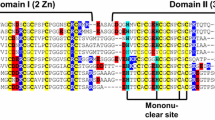Summary
Heterologous expression in E.coli, coupled with spectroscopic analyses, has enabled the metal binding properties of the recombinant mouse Zn-MT, Zn-αMT and Zn-βMT to be characterized. Cd(II) binding properties of Zn7-MT and Zn4-αMT have shown that they behave like the native proteins and those of the Zn3-βMT fragment have been reported for the first time. In contrast, the behavior of these proteins towards Hg(II), Cu(I) and Ag(I), which is strongly influenced by the pH and the stabilization time, differs from that of the native forms. Furthermore, recombinant Cd-βMT has also been expressed and characterized.
Access this chapter
Tax calculation will be finalised at checkout
Purchases are for personal use only
Preview
Unable to display preview. Download preview PDF.
Similar content being viewed by others
References
Kille P, Lees WE, Darke BM, Winge DR, Dameron CT, Stephens P, Kay J (1992) Sequestration of cadmium and copper by recombinant rainbow trout and human metallothioneins and by chimeric (mermaid and fish-man) proteins with interchanged domains. J Biol Chem 267: 8042–8049.
Wang YJ, Mackay EA, Kurasaki M, Kägi JHR (1994) Purification and characterization of recombinant sea urchin metallothionein expressed in Escherichia coli. Eur J Biochem 225: 449–457.
Odawara F, Kurasaki M, Suzuki-Kurasaki M, Oikawa S, Emoto T, Yamasaki F, Linde Arias AR, Kojima Y (1995) Expression of human metallothionein-2 in Escherichia coli: cadmium tolerance of transformed cells. J Biochem 118: 1131–1137.
Sewell AK, Jensen LT, Erickson JC, Palmiter RD, Winge DR (1995) Bioactivity of metallothionein-3 correlated with its novel β domain sequence rather that metal binding properties. Biochemistry 34: 4740–4747.
Kurasaki M, Emoto T, Linde-Arias AR, Okabe M, Yamasaki F, Oikawa S, Kojima Y (1996) Independent self-assembly of cadmium-binding α-fragment of metallothionein in Escherichia coli without participation of b-fragment. Protein Engng 9: 1173–1180.
Glanville N, Durnam DM, Palmiter RD (1981) Structure of mouse metallothionein-I gene and its mRNA. Nature 292: 267–269.
Capdevila M, Cols N, Romero-Isart N, Gonzalez-Duarte R, Atrian S, González-Duarte P (1997) Recombinant synthesis of mouse Zn3-β and Zn4-α metallothionein 1 domains and characterization of their cadmium(II) binding capacity. Cell Mol Life Sci (formerly Experientia) 53: 681–688.
Cols N, Romero-Isart N, Capdevila M, Oliva B, Gonzalez-Duarte P, González-Duarte R, Atrian S (1997) Binding of excess cadmium(II) to Cd7-metallothionein from recombinant mouse Zn7-metallothionein 1. UV-VIS absorption and circular dichroism studies and theoretical location approach by surface accessibility analysis. J Inorg Biochem 68: 157–166.
Capdevila M, Romero N, Cols N, Atrian S, Stillman MJ, González-Duarte R, González-Duarte P (1996) Cadmium(II) binding to recombinant mouse Zn3-βMT metallothionein 1. Anal Quim Int Ed 92: 199–201.
Lu W, Stillman MJ (1993) Mercury thiolate cluster in metallothionein. Analysis of circular dichroism spectra of complexes formed between α-metallothionein, apometallothionein, zinc metallothionein and cadmium metallothionein and Hg2+. J Amer Chem Soc 115: 3291–3299.
Lu W, Zelazowski A, Stillman MJ (1993) Mercury binding to metallothioneins: Formation of the Hg18-MT species. Inorg Chem 32: 919–926
Zelazowski A, Stillman MJ (1992) Silver binding to rabbit liver zinc metallothionein and zinc a and b fragments. Formation of silver metallothionein with Ag(I): Protein ratios of 6, 12 and 18 observed using circular dichroism spectroscopy. Inorg Chem 31: 3363–3370.
Li YJ, Weser U (1992) Circular dichroism, luminiscence, and electronic absorption of copper binding sites. Inorg Chem 31: 5526–5533.
Li H, Otvos JD (1996) HPLC characterization of Ag+ and Cu+ metal exchange reactions with Zn- and Cdmetallothioneins. Biochemistry 35: 13937–13945.
Bond MD, Holmquist B, Vallee BL (1986) Thioamide substrate probes of metal-substrate interactions in carboxypeptidase A catalysis. J Inorg Biochem 28: 97–105.
Okada Y, Ohta M, Yagyu M, Min KS, Onosaka S, Tanaka K (1985) Synthesis of a nanocosapeptide (β-fragment) corresponding to the N-terminal sequence 1–29 of human liver metallothionein II and its heavy metal-binding properties. FEBS Lett 183: 375–378.
Okada Y, Ohta N, Iguchi S, Tsuda Y, Sasaki H, Kitagawa T, Yagyu M, Min KS, Onosaka S, Tanaka K (1986) Amino acids and peptides XIII. Synthesis of a nonacosapeptide corresponding to the N-terminal sequence 1–29 (β-fragment) of human liver metallothionein II (hMTII) and its heavy metal-binding properties. Chem Pharm Bull 34: 986–998.
Kull FJ, Reed HF, Elgree TE, Ciardelli TL, Wilcox DE (1990) Solid-phase peptide synthesis of the α and β domains of liver metallothionein 2 and the metallothionein of Neurospora crassa. J Amer Chem Soc 112: 2291–2298.
Stillman MJ, Cai W, Zelazowski AJ (1987) Cadmium binding to metallothioneins. Domain specificity in reactions of α and β fragments, apometallothionein, and zinc metallothionein with Cd2+. J Biol Chem 262: 4538–4548.
Romero N, Capdevila M, González-Duarte P, Oliva B (1996) Computational analysis of cysteine substitutions modeled on the α and β domains of Cd5,Zn2-metallothionein 2. J Mol Model 2: 1–5.
Author information
Authors and Affiliations
Editor information
Editors and Affiliations
Rights and permissions
Copyright information
© 1999 Springer Basel AG
About this chapter
Cite this chapter
Atrian, S. et al. (1999). Recombinant synthesis and metal-binding abilities of mouse metallothionein 1 and its α- and β-domains. In: Klaassen, C.D. (eds) Metallothionein IV. Advances in Life Sciences. Birkhäuser, Basel. https://doi.org/10.1007/978-3-0348-8847-9_8
Download citation
DOI: https://doi.org/10.1007/978-3-0348-8847-9_8
Publisher Name: Birkhäuser, Basel
Print ISBN: 978-3-0348-9799-0
Online ISBN: 978-3-0348-8847-9
eBook Packages: Springer Book Archive




